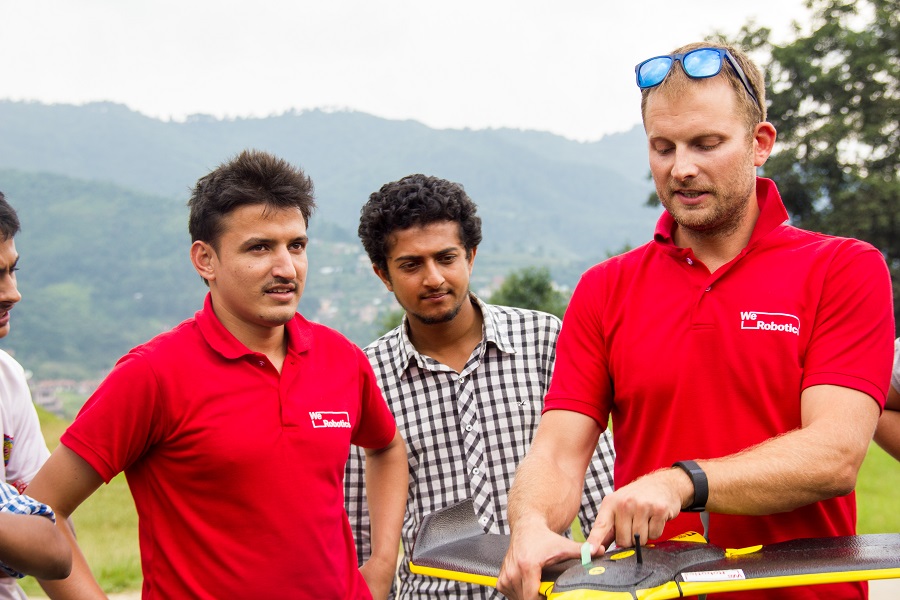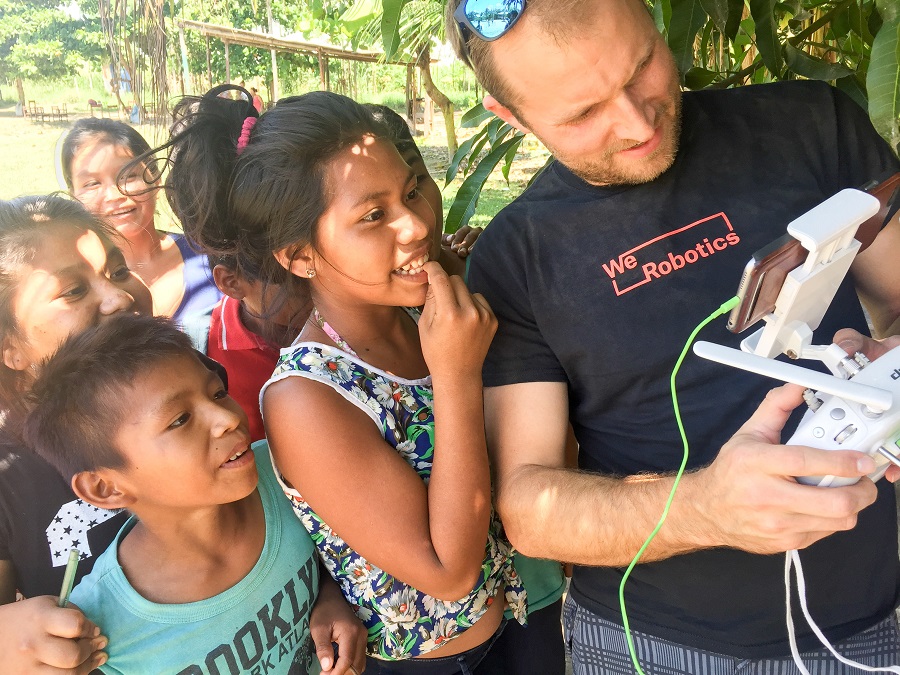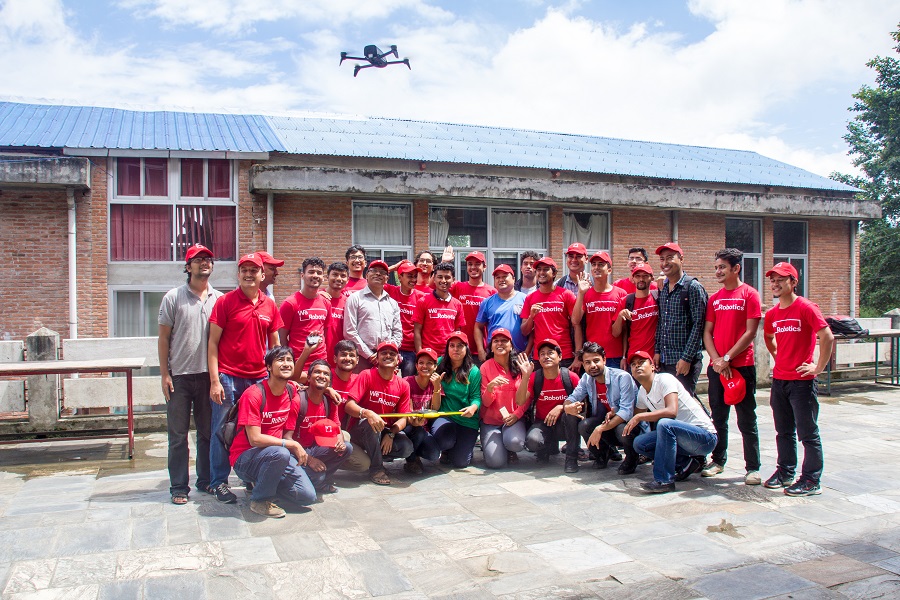
Robohub.org
Drones for good 2.0: How WeRobotics is redefining the use of unmanned systems in developing countries

Robotics undoubtedly has the potential to improve lives in the developing world. However, with limited budgets and expertise on the ground, putting this technology in place is no small task. Step forwards WeRobotics, a new Swiss/American NGO dedicated to meeting this goal through the creation of in-country ‘flying labs’. Co-founder Adam Klaptocz explains all.
Hey Adam. Let’s start with this: what is WeRobotics?
WeRobotics is a non-governmental organisation (NGO) dedicated to bringing developing countries access to robotics technology. Such countries don’t have access because of economics, supply chains and many other reasons. Our role is to help local people learn and use this technology, and then to deploy it for social good projects within their own communities.
We do this by establishing ‘flying labs’ in different countries. The goal of each is to serve as a hub of robotics technology, where staff host training sessions, webinars and teach people how to use technology. Each lab will have drones and software, on hand and in the cloud, thanks to our technology company partners. Labs will also function as an incubator for new, local, drone-based businesses.

WeRobotics co-founder Adam Klaptocz (right) and Nepal Flying Labs Coordinator Uttam Pudasaini, running a drone mapping training session in Kathmandu, Nepal.
And who is behind WeRobotics?
We have four co-founders; myself and Sonja Betschart are based in Switzerland, and Patrick Meier and Andrew Schroeder, who are based in the U.S. We are a 501c3 non-profit organisation in the United States and have just founded a sister organisation in Switzerland too. Besides that, all of our flying labs will be legal entities as well, to go along with the concept of building local capacities and driving local engagement.
The goal is to engage local lab coordinators, local organisations, and ideally make the local flying lab its own organisation that has its own activities and is sustainable
The goal is to engage local lab coordinators, local organisations, and ideally make the local flying lab its own organisation that has its own activities and is sustainable
The goal is to engage local lab coordinators, local organisations, and ideally make the local flying lab its own organisation that has its own activities and is sustainable
And you’re talking about unmanned robots in their most general sense, not just as a synonym for flying drones?
That’s right. At WeRobotics, we’re looking at robotics in the largest sense—it’s not just eBee drones for mapping, it’s also things like drones for delivery, marine robots, underwater robots, and terrestrial robots. Anything to do with robotics and the technical ecosystem that goes around it. That includes the software and the platforms people use to share a drone’s data because, in the end, drones are just a tool for collecting and turning the data into actionable information.
We have tech partners, such as senseFly and other drone and software companies, with whom we are spreading this technology throughout our network of labs. The labs will then run training programmes, serve as incubators for locals who want to get into the business, and host conferences where these adopters can share their experiences.
So do you already have your first lab set-up? Where is that?
Absolutely, we’re a young NGO, but we’re trying to expand quite quickly.
Our first lab was officially launched recently in Nepal. It’s called Nepal Flying Labs. We have a local lab coordinator there and we’ve partnered with Kathmandu University, ICIMOD, which is a mountain and glacier study organisation, NAXA and Medair. We’re working with government agencies as well, including the survey department of the Nepalese government. So we have a certain number of partners that we’re working with to roll out projects and run trainings.
We have projects that will be running throughout the next year in Kathmandu and the surrounding areas; a lot of which is post-earthquake reconstruction work after last year’s earthquake. Also, a lot of climate-based research work.
That must be ground zero, that region, for such scientific study?
Exactly. Nepal is basically a giant mountain so the effects of climate change are really affecting communities there. There are a lot of landslides – the Himalayas are melting, the glaciers are melting – so there is a lot of work to be done in terms of disaster prevention and also in post-disaster reconstruction.
And in Tanzania, where we are setting up more flying labs. I know there’s already been a lot of work there by senseFly, Drone Adventures [case study], The World Bank and other organisations. We’re hoping to work with these organisations and others to consolidate a lot of the work that’s been done; to make it sustainable for years to come within Tanzania.
Our third major lab that we are setting up before the end of the year is in Peru. In Peru, we will start in the Amazon. Our first pilot project there is about drone delivery, but we’ll also be spinning out drone mapping as a business and other types of robotics as well.
In the countries where you operate, is one of the groups you’re engaging with the government itself? Do you see your role to also help governments regulate the use of drones?
The mandate of each flying lab, as an NGO, isn’t to replace government, it’s to help.
So the first thing to do is to work with the government and try to help boost, for example, its capacity for mapping. That’s something that we believe in strongly. We’re already working with the survey department in Kathmandu and we’ll be working with the Lands Department in Tanzania as well to try to reinforce their capacity to serve their own people. On top of that, of course, we want to be able to work within countries – within the rules of those countries – and so we’re trying to help with regulations, by working with the regulatory authorities in all of these countries.
A lot of developing countries are looking for guidance from other countries – where robotic technology might be a little more established – to see what is happening. That’s another thing that we hope, as an international NGO with locations all around the world, we’ll be able to facilitate—helping governments to learn what works in other countries, such as those our network covers, and helping them to work together, often with the civil aviation authority and other government agencies. It’s about implementing rules that make drone use responsible, but also leave the market open so that we can incubate businesses. Like that, the economy can develop around this technology instead of being blocked.
You mentioned before we started recording that the key, underpinning what WeRobotics is about, is building capacity on the ground.
Yes, that’s the key, local capacity. It shouldn’t have to be that a bunch of foreigners come in to do this work whichever way they want, often with their own desires, with their own culture and their own needs. Basically, making themselves feel good about helping instead of actually helping.
What would be best, if this ever happens again in Nepal, is that there are enough drone companies locally that know what they’re doing, and understand the legal framework within the country, so that they can do the job instead of having to bring in foreigners. And that goes for every country. I think that, in development, the more local capacity you build, the more you can really bring the country out of poverty so that it can have its economy self-sustain itself.
That’s our goal with the flying labs: to build self-sustainable local entities that build local capacity but have global contact with other labs and with our global technology partners.
What specific UAV platforms do you operate at present and how are these being used?
I truly believe that every job has a tool that’s best adapted to it. In Nepal, right now, our flying lab has aneBee and a Parrot Bebop drone. The eBee is used because Nepal is obviously very mountainous and having the capacity to deal with 3D flight mapping is very important.

Meanwhile, in Tanzania there are larger, mainly flat zones to be mapped. For that we have a Sky-Watch Cumulus drone. This is a longer-range drone that can fly for two hours and cover very large areas. So there that’s the best adapted drone. We’re also bringing a Bebop to Tanzania, because there is a big interest in drone journalism there and for that it’s important to have something that is small, cheap and easily deployed.
Then in Peru, we’re working with hybrid drones that are made more for cargo delivery. One option isQuantum Systems, which is a German company that makes even bigger, VTOL drones with an even bigger payload capacity.
So, different drones for different jobs.
100% platform agnostic.
Yes. One of our goals as an NGO is to remain more or less independent of technology. What’s important is that the job can be done with the best fit technology, in an economically viable way. We need UAVs that are easy to use, easy to train on, and relatively mature as well.
One of our goals as an NGO is to remain more or less independent of technology. What’s important is that the job can be done with the best fit technology, in an economically viable way.
We do work with some startups, but in general what you really need, if you want to make something work in the jungles of Papua New Guinea or in the middle of the desert somewhere, is a machine that’s durable and that has existed for a little while. A platform that has some sort of customer support is needed too, so it’s important that our technology company partners are happy to be involved as well.
If you imagine a few years down the road, having achieved your short and medium term goals, how does the world of WeRobotics look then?
We see ourselves, a few years down the road, having many flying labs around the world. We’re not sure if we’ll have five, or ten, or if there’ll be 50, but the goal is that we have setup a network of many flying labs in different countries.
And you’re planning on developing some in-house engineering capacity too?
Yes, because there are many problems, like conservation in developing countries, which can be solved with existing technology. But there are also many problems that can be solved with technology, but the technology doesn’t exist yet, because the people developing the technology—whether it’s Silicon Valley, China, or Europe—aren’t necessarily aware of the problems that exist in developing countries.

Whatever works, whatever’s needed to meet your goals on the ground then?
Yes. Unfortunately, there is no lack of work in development. Poverty is not disappearing next year. It’s not a market that you have to grasp today otherwise tomorrow it has been taken over. There is a huge amount of work left to do, and there’s definitely enough to go around.
If you liked this article, you may also be interested in:
- Cargo drones deliver in the Amazon rainforest
- The Drone Center’s Weekly Roundup: 2/13/17
- The art of drone flight: Creating drone costumes
- The Monospinner: world’s mechanically simplest controllable flying machine
- Flying cars are coming, what will they mean?
See all the latest robotics news on Robohub, or sign up for our weekly newsletter.
tags: c-Aerial, cx-Politics-Law-Society, cx-Research-Innovation, Drone, Flying, interview, robot, UAV, WeRobotics




